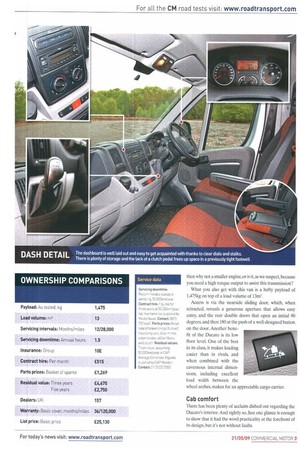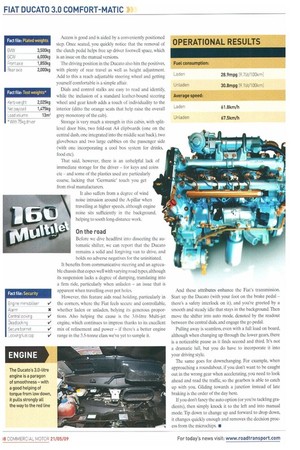In this brave new 'green' world of hybrid technology and
Page 36

Page 37

Page 38

If you've noticed an error in this article please click here to report it so we can fix it.
electric vehicles, the humble automated transmission continues to evolve at a more sedate pace on LCVs, remaining very much an option on a number of buyers' wish lists.
Blame, arguably. could be pointed towards the manufacturers, which haven't yet developed a product that comes complete with all the benefits — namely increased fuel economy and decreased component wear — and none of the negatives, such as protracted gear changing and cogchoice indecision.
So while truck companies have a product that improves driveability and fuel economy over most manual efforts, which have, in turn, exploded in popularity, their smaller brethren still lack that degree of dynamism, suffering from hesitant shifting and clunky operation.
All this means that Fiat's automated option on its Ducato van, optimistically named Comfort-Matic, has something of a challenge on its hands to win over the CM test team.
Available only in conjunction with its top engine option, the 3.0-litre, 157hp unit (the 2.2 100hp and 2.3 130hp engines are only available in manual), this six-speed automated manual is a £1,155 option.
And with the smallest version on this 3.5-tonne van (long wheelbase, high roof as tested here) costing £24,015, before you add the aforementioned (or any other) option, hands-free shifting doesn't come cheap. As rivals go, Mercedes-Benz has a five-speed torque converter auto option on its Sprinter for £995; Volkswagen has the Shiftmatic at £750 for its Crafter; and Iveco (part of Fiat), has the same Agile option on its Daily for £790.
Productivity
With big claims of reduced fuel consumption, the ComfortMatic had plenty to live up to on CM's test route. However, since the drive takes in not just urban work, but motorways and A-roads (and, therefore, less gear changing), the final result was destined to fall short of Rat's claim of 10%.
With a laden run, we recorded 28.9mpg, which, for a 3.0-litre engine, was a solid result but not a revelation, although this improved to 30.8mpg when unladen.
We still question the wisdom of mating the auto to a large-capacity engine. If you want improved fuel economy,
then why not a smaller engine, or is it, as we suspect, because you need a high torque output to assist this transmission?
What you also get with this van is a hefty payload of 1,475kg on top of a load volume of 13m3.
Access is via the nearside sliding door, which, when retracted, reveals a generous aperture that allows easy entry, and the rear double doors that open an initial 90 degrees, and then 180 at the push of a well-designed button on the door. Another benefit of the Ducato is its low floor level. One of the best in its class, it makes loading easier than in rivals, and when combined with the cavernous internal dimensions, including excellent load width between the wheel arches, makes for an appreciable cargo carrier.
Cab comfort
There has been plenty of acclaim dished out regarding the Ducato's interior. And rightly so. Just one glance is enough to show that it had the word practicality at the forefront of its design, but it's not without faults. Access is good and is aided by a conveniently positioned step. Once seated, you quickly notice that the removal of the clutch pedal helps free up driver footwell space, which is an issue on the manual versions.
The driving position in the Ducato also hits the positives, with plenty of rear travel as well as height adjustment. Add to this a reach adjustable steering wheel and getting yourself comfortable is a simple affair.
Dials and control stalks are easy to read and identify, while the inclusion of a standard leather-bound steering wheel and gear knob adds a touch of individuality to the interior (ditto the orange seats that help raise the overall grey monotony of the cab).
Storage is very much a strength in this cabin, with splitlevel door bins, two fold-out A4 clipboards (one on the central dash, one integrated into the middle seat back), two gloveboxes and two large cubbies on the passenger side (with one incorporating a cool box system for drinks, food etc).
That said, however, there is an unhelpful lack of immediate storage for the driver for keys and coins etc and some of the plastics used are particularly coarse, lacking that 'Germanic' touch you get from rival manufacturers.
It also suffers from a degree of wind noise intrusion around the A-pillar when travelling at higher speeds, although engine noise sits sufficiently in the background, helping to sooth long-distance work.
On the road
Before we dive headfirst into dissecting the automatic shifter, we can report that the Ducato remains a solid and forgiving van to drive, and holds no adverse negatives for the uninitiated.
It benefits from communicative steering and an agreeable chassis that copes well with varying road types, although its suspension lacks a degree of damping, translating into a firm ride, particularly when unladen an issue that is apparent when travelling over pot holes.
However, this feature aids road holding, particularly in the corners, where the Fiat feels secure and controllable, whether laden or unladen, belying its generous proportions. Also helping the cause is the 3A1-litre Multi-jet engine, which continues to impress thanks to its excellent mix of refinement and power if there's a better engine range in the 3.5-tonne class we've yet to sample it. And these attributes enhance the Fiat's transmission. Start up the Ducato (with your foot on the brake pedal there's a safety interlock on it), and you're greeted by a smooth and steady idle that stays in the background. Then move the shifter into auto mode, denoted by the readout between the central dials, and engage the go pedal.
Pulling away is seamless, even with a full load on board, although when changing up through the lower gears, there is a noticeable pause as it finds second and third. It's not a dramatic lull, but you do have to incorporate it into your driving style.
The same goes for downchanging. For example, when approaching a roundabout, if you don't want to be caught out in the wrong gear when accelerating, you need to look ahead and read the traffic, so the gearbox is able to catch up with you. Gliding towards a junction instead of late braking is the order of the day here.
If you don't fancy the auto option (or you're tackling gradients), then simply knock it to the left and into manual mode. Tip down to change up and forward to drop down, it changes quickly enough and removes the decision process from the microchips.
















































































































































